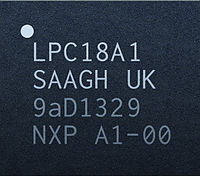
Back أبل إم 7 Arabic Apple M7 Catalan Apple M7 German Apple M7 Spanish Apple M7 French 애플 모션 보조 프로세서 Korean Apple M7 Portuguese Сопроцессоры обработки слежения за движением Russian Apple M7 Turkish Bộ đồng xử lý chuyển động Apple Vietnamese
 The NXP LPC18A1, also known as the M7 motion coprocessor | |
| General information | |
|---|---|
| Launched | September 2013 |
| Designed by | M7, M8: NXP Semiconductors |
| Common manufacturer |
|
| Product code | M7: LPC18A1[1] M8: LPC18B1[2] |
| Performance | |
| Max. CPU clock rate | 150[3] MHz |
| Architecture and classification | |
| Technology node | 90 nm[3] |
| Microarchitecture | Cortex-M3[3] |
| Instruction set | ARMv7-M[3] |
| Physical specifications | |
| Cores |
|
The Apple M-series coprocessors are motion coprocessors used by Apple Inc. in their mobile devices. First released in 2013, their function is to collect sensor data from integrated accelerometers, gyroscopes and compasses and offload the collecting and processing of sensor data from the main central processing unit (CPU).
The first coprocessor of the series is the M7 (codename Oscar), which was introduced in September 2013 as part of the iPhone 5S.[4][5] Chipworks found that the M7 most likely is a NXP LPC1800 based microcontroller called LPC18A1. It uses an ARM Cortex-M3 core with a customised packaging and naming scheme indicating that it is for an Apple customized part.[1] The updated version M8 was introduced in September 2014 with the iPhone 6 and also processes data from the barometer that is included in the iPhone 6 and iPad Air 2.[6][7] iFixit have identified the M8 in the iPhone 6 to be an NXP device with a very similar name, the LPC18B1.[2][8]
The later coprocessors are embedded into the A-series SoCs. September 2015 brought the M9 motion coprocessor embedded within the A9 chip found in the iPhone 6S, iPhone 6S Plus,[9] first-generation iPhone SE[10] and within the A9X chip found in the first-generation iPad Pro.[11] The iPhone 7, iPhone 7 Plus,[12] second-generation iPad Pro feature the M10 motion coprocessor, embedded within the A10 Fusion and the A10X Fusion chips.[13] Apple included the M11 in the iPhone 8, 8 Plus and iPhone X, embedded within the A11 Bionic SoC.[14]
Starting with the A12 Bionic SoC, Apple has stopped distinguishing the motion coprocessor from the rest of the SoC, and has abandoned the corresponding M-series nomenclature.[15] The M-series nomenclature was reintroduced in 2020 for ARM-based SoCs used in Mac computers and iPad tablets (starting from the 5th generation iPad Pro).
- ^ a b c Tanner, Jason; Morrison, Jim; James, Dick; Fontaine, Ray; Gamache, Phil (September 20, 2013). "Inside the iPhone 5s". Chipworks. Archived from the original on August 3, 2014. Retrieved September 20, 2013.
- ^ a b "iPhone 6 Plus Teardown". iFixit. Retrieved 2014-09-20.
- ^ a b c d e NXP 150 MHz, 32-bit Cortex-M3 microcontrollers LPC1800 (PDF) (Technical report). NXP Semiconductors. September 2010. 9397 750 17002. Retrieved September 20, 2013.
- ^ Estes, Adam Clark (2013-09-10). "How Apple's M7 Chip Makes the iPhone 5S the Ultimate Tracking Device". Gizmodo. Retrieved 2013-09-13.
- ^ Sumra, Husain (2013-09-10). "iPhone 5s Includes New 'M7' Motion Coprocessor for Health and Fitness Tracking". MacRumors. Retrieved 2013-09-13.
- ^ "iPhone 6 - Technology". Apple. Archived from the original on 2014-09-09.
- ^ "iPad Air 2 - Performance". Apple. Archived from the original on 2014-10-16.
- ^ "iPhone 6 Teardown". iFixit. Retrieved 2014-09-20.
- ^ "Apple Introduces iPhone 6s & iPhone 6s Plus" (Press release). Apple. 2016-09-09.
- ^ "iPhone SE - Technical Specifications". Apple. Archived from the original on 2016-06-16. Retrieved 2016-06-14.
- ^ "iPad Pro". Apple. Archived from the original on 2015-09-13.
- ^ "iPhone 7 - Technical Specifications". Apple. Archived from the original on 2016-09-08. Retrieved 2016-09-08.
- ^ "iPad Pro - Technical Specifications". Apple. Archived from the original on 2018-09-15. Retrieved 2018-09-15.
- ^ "iPhone X - Technical Specifications". Apple. Archived from the original on 2017-09-17. Retrieved 2017-09-17.
- ^ "iPhone XS - Technical Specifications". Apple. Archived from the original on 2018-09-27. Retrieved 2018-09-27.